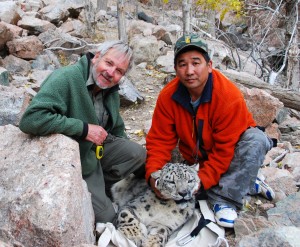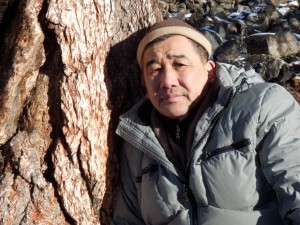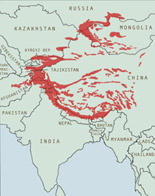Mongolia has the second largest number of snow leopards. In recent times I’ve had the opportunity to meet one of the country’s most respected biologists and a leader in snow leopard conservation, Dr Bariushaa Munkhtsog.
Munkhtsog was born in western Mongolia and is founder of the Irbis (the word is Mongolian for Snow Leopard) Centre which supports snow leopard research and conservation. His doctorate thesis was on “Snow leopard biology, ecology and conservation in Mongolia”. He is currently a senior wildlife biologist at the Mammalian Ecology Laboratory of the Institute of Biology, Mongolian Academy of Sciences in Ulaanbaatar.
Animated and passionate, Munkhtsog is always happy to talk about snow leopards. He is a great communicator and has his own Facebook page. In the early 1990’s he and journalist D. Shagdarsuren ran a successful program on Mongolian national public radio called “Do not disturb endangered snow leopards.” Since then he has worked together with many local and international researchers and conservationists and been a consultant for more than 10 international TV programs on Mongolian endangered wildlife.

Dr Rodney Jackson and Dr Bariushaa Munkhtsog with radio collared snow leopard in 2008. (Photo Snow Leopard Conservancy.)
Munkhtsog is rightly proud of his work. He says, “Everybody in Mongolia knows that snow leopard is endangered. I know almost everybody who lives in snow leopard habitat, seems they know me, so it is quite easy to work together on conservation of beautiful, quiet, kind animal like snow leopard”.
Munkhtsog, how did you become involved with snow leopard research?
“I was lucky to work with endangered wildlife in 1990’s, first with Przewalski’s horse (an endangered species of wild horse native to the steppes of Central Asia). One day when I worked in Hustai National Park, my supervisor and vice president of the Mongolian Association for Conservation of Nature, Mr J. Tserendeleg, asked me, “We are close to start snow leopard research project, would you like to work in that project as a field biologist?” I said, yes, of course and I became a research partner and friend of Dr Tom McCarthy who has worked with snow leopards for a long time.
So I started with snow leopards at Great Gobi protected area as a field assistant. Tom and I both learned a lot in the field collaring and doing telemetry of snow leopards. During this study an old female cat was collared with satellite collar first time in the world. Later the Snow Leopard Trust became a partner and they started implementation of community based conservation project, Irbis enterprises in 1997. Now women make crafts and sell them in return for protecting snow leopards. “
What are the projects you are working on and where are they?
“Recently I was happy to work with Chinese biologists in Xinjiang, training them on snow leopard survey methodology and with Russian colleagues in transboundary areas of Mongolia and Russia confirming their knowledge on snow leopard sign surveys and checking the camera traps.
Nowadays I work in many parts of Mongolia on snow leopard conservation, including Baga Bogd mountains, Jargalant National Park and in Tost mountains where we conduct snow leopard camera trap population monitoring. In Mongolia there are 20 state protected areas harbor snow leopards. Now I am working together for many years with parks to improve capacity and training staff.
I work with Snow Leopard Trust (SLT) and also Dr Rodney Jackson of Snow Leopard Conservancy (SLC). With SLC and Dr Jan Janecka we study snow leopard genetics in Mongolia.
Other work is on conservation plans, developing and implemented in Mongolia to conserve endangered snow leopards and prey and habitat. This means discussion with parliament and even Mongolian cabinet. And also country paln for the Global Snow Leopard and EcoSystem protection program (GLSEP). On local level we involve local herders and communities in conservation too.”
What are your biggest challenges?
“Park staff, local communities are doing their best for snow leopard conservation, collecting information themselves using little amount of money ($400) and supporting our activities. We are as academic institution, conducting surveys, analyzing the data and developing recommendations. But sorry to see that local conservation communities, administration, parks do not have funds to implement our recommendations even when they want it very much.”
What is your hope for the future of snow leopards and the people sharing their home range?
“I hope that wildlife can be next to people and not afraid. That there is no hunting. We are conserving snow leopards in Mongolia for 20 years and since 2008 we see them more in the open. We have even seen them on the roof of a ger (yurt like tent) of a local herder. Also I saw one under the park jeep and also we’ve seen a female with 3 cubs in the open at four study sites. I am assuming that snow leopards are coming closer to us not because food or prey are getting scarce, but because people have almost stopped to disturb them in many areas of Mongolia. I hope there is a time when there are more snow leopards and people wouldn’t harm them”.
Thank you Munkhtsog for sharing your story with our readers and we wish you all the best with your vital work.







Comments on this entry are closed.